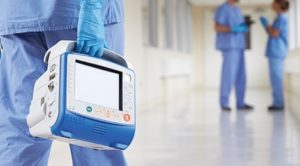 Many hospitals struggle to keep tabs on valuable equipment they need to treat patients. Several valuable machines, such as transport monitors and cardiac defibrillators, are used by multiple departments and staff members within a hospital, and especially during busy periods it can be hard to track one down when you need it the most. This leads to numerous complications, from jeopardizing patient care to overstocking of equipment to prevent these issues from occurring in the first place. Most hospitals haven’t come up with a workable solution to this problem, relying on sign-out sheets or honesty policies to make sure equipment is returned after use.
Many hospitals struggle to keep tabs on valuable equipment they need to treat patients. Several valuable machines, such as transport monitors and cardiac defibrillators, are used by multiple departments and staff members within a hospital, and especially during busy periods it can be hard to track one down when you need it the most. This leads to numerous complications, from jeopardizing patient care to overstocking of equipment to prevent these issues from occurring in the first place. Most hospitals haven’t come up with a workable solution to this problem, relying on sign-out sheets or honesty policies to make sure equipment is returned after use.
Because these devices often fall under the cost or size requirements of an RTLS battery, they often go untracked on hospital floors. A new tracking system developed by Mobile Aspects aims to solve this problem by pairing smart RFID cabinets with intelligent alerts and analytics to ensure the efficient use and reliable tracking of reusable medical equipment.
iRISupply RE is a reusable medical equipment tracking system that has been used by hospitals to track several types of reusable equipment that have proven to be of high value to the organization and hard to track. Some examples of items tracked by iRISupply RE include:
- Transport patient monitors
- Cardiac defibrillators
- Personal protective equipment (PPE)
- Electrophysiology cables
- Laptop computers / tablets
- Vocera communication badges and batteries
- Pulse oximeters
iRISupply RE includes asset tracking smart cabinets that use RFID technology to automatically track items to the user who removed them. The cabinets can be outfitted with chargers for any electronic equipment that is being stored. This ensures that when equipment is needed, it is fully charged for its next use.
The true value of iRISupply RE lies in the data that the system generates. The data is continuously analyzed by artificial intelligence to understand when breaches have occurred. For example, some sites have set up alerts to be sent whenever multiple pieces of the same equipment have been checked out by the same user. Other sites have set thresholds so that whenever a piece of equipment hasn’t been returned after a certain time period, say 12 hours, then an administrator will be immediately notified.
By improving their visibility into the chain of custody of assets, hospitals can drastically reduce their spend on replacement equipment and save a lot of time and money in the process. They can also reduce the number of patient safety issues brought on by missing equipment. The data and reports generated by the system can be used to decide on the optimal number of each piece of equipment to own and to help make better buying decisions. Data can also be used to help train repeat offenders on how to follow the hospital’s policies.
